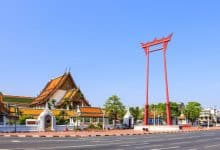Vietnam flings open the doors, Thailand and Malaysia peek through the curtains

Peeking through the curtains and testing the water, or flinging wide the door and going for it. Or somewhere in between.
Some South east Asian countries are starting to make cautious preparations to lift lockdown and travel restrictions. But this isn’t a competition – each country is having to look at the myriad of local issues as they factor in steps to re-open their economies. And every South east Asian country has different priorities.
Vietnam has already ended the government’s “social distancing measures” this week, except in some districts of the northern capital Hanoi. The Vietnamese health authorities reported no new cases for seven days in a row, giving them the confidence of being the first of the ten nations to reboot their economy.
But compared to the rest of the world the numbers in South east Asia have been tiny. In fact, all added up, South east Asia’s reported cases make up a minuscule 1.3% of the world’s cases (despite widespread belief that the numbers in Indonesia are actually a lot higher than reported). In comparison, the case numbers in the US have burst through the 1 million mark in the past 24 hours, with more than 56,000 deaths. Spain, Italy, France and the UK are also still struggling to contain the coronavirus, all with more than 20,000 deaths.
Singapore, an island state of only 5.6 million people, leads the way in the region with nearly *15,000 cases (mostly migrant workers). Meanwhile the most populous of the South east Asian nations, Indonesia, with a population of 264 million, is in second place with *9,511 reported cases. But Reuters today published a report that there have already been 2,200 deaths in the archipelago, three times the officially of *773 deaths.
The stark difference in the tallies, relative to their populations, has been put down to the quality of the testing regimes in the two countries – none of the region’s epidemiologists believe Indonesia is correctly reporting case numbers. The city-state has struggled to control the epidemic, mainly among migrant workers. Singapore has discovered over 7,000 new cases in the past seven days alone.
* Figures as of 1930 Tuesday, Thai time
Thailand, Malaysia, Indonesia, Singapore and the Philippines imposed levels of restrictions after infections started to climb. In Thailand there was a national nighty curfew, closure of all non-essential shops, rules about the wearing of masks and travel restrictions, keeping Thai’s within the borders of their provinces (and some cases within the boundaries of their suburbs).
Today Thailand has extended it emergency decree, a state of emergency giving their prime minister sweeping powers to make instant decisions. The state of emergency now runs to the end of May despite the number of ne cases slowing to a trickle over the past week.
But preparations for easing restrictions around Thailand are now apparent. The cabinet is considering decreasing the level of intensity and scope of restrictions that affect the normal operation of Thai businesses. Thais look forward to a gradual easing of the draconian restrictions in coming weeks.
But the nation’s most pressing problem will be to figure out how to salvage it’s valuable tourism industry, said to contribute from 15-18% of the country’s total GDP. The tourist magnets, like Phuket and Pattaya, have been devoid of tourists for nearly two months and the shops and bars remain shuttered. Although restrictions may soon be lifted, allowing some semblance of trade, there is unlikely to be any resurgence in Thai tourism until sometime in 2021.
A lot will depend on other countries re-opening their borders, the aviation industry finding a way to sustain scheduled flights and a willingness of international travellers to get back on planes. And will they have the money anyway? And will insurance companies provide insurance for travellers until a viable vaccine is on the market?
Latest Thailand News
Follow The Thaiger on Google News:


























